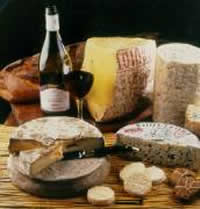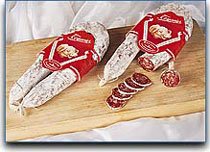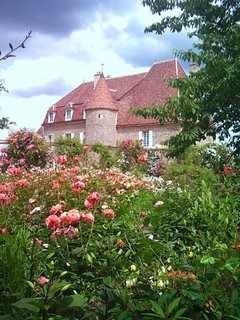Charles-Henri and his frommages.....
 Outline of l'Hexagonne (France) and all of her glorious, smelly cheeses by region.
Outline of l'Hexagonne (France) and all of her glorious, smelly cheeses by region.
 Who doesn't like Roquefort? Give me some walnuts, sour apple and my blue Roquefort, and you will have a very happy woman on your hands!
Who doesn't like Roquefort? Give me some walnuts, sour apple and my blue Roquefort, and you will have a very happy woman on your hands!
 Foie Gras. Yes, I know the methods are creul, but can you resist the divine buttery heavely experience?
Foie Gras. Yes, I know the methods are creul, but can you resist the divine buttery heavely experience?

 Eclairs..... did you know that in French, "eclair" means "lightning." Does that explain the almost electric pleasure that comes with biting into one?
Eclairs..... did you know that in French, "eclair" means "lightning." Does that explain the almost electric pleasure that comes with biting into one? Croissants, Pain au Rasin (rasin croissant), Pain au Chocolat (chocolate-filled croissant). Need I say more?
Croissants, Pain au Rasin (rasin croissant), Pain au Chocolat (chocolate-filled croissant). Need I say more?
 Escargots...Now come on, anything drenched in butter, garlic and herbs must be good, right?
Escargots...Now come on, anything drenched in butter, garlic and herbs must be good, right?
 Okay, this one needs a little explaining... Angelina Salon de The (Tea House) is one of the most wonderful experiences I've ever had. This is truly a very "feminine" experience, only to be enjoyed by those who enjoy both gustatory, visual and affective refinement, ALL AT ONCE!
Okay, this one needs a little explaining... Angelina Salon de The (Tea House) is one of the most wonderful experiences I've ever had. This is truly a very "feminine" experience, only to be enjoyed by those who enjoy both gustatory, visual and affective refinement, ALL AT ONCE!
I suppose that there are some people who do actually order tea in this "tea house," but I don't understand why. Angelina's serves the best, most creamy, thick, almost pudding-like hot chocolate (chocolate chaud) accompanied by another cup of freshly whipped-cream.
The ambiance is elegant. Golden guilded ceiling and walls, Louis-VI style lumpy chairs, white tableclothes, fresh flowers on each table, and waitresses in cute little "French Maid" uniforms.

 Yes, you can also order other things..... fresh squeezed juices, tartes, and other pastries.... Perhaps to go along with your hot chocolate?
Yes, you can also order other things..... fresh squeezed juices, tartes, and other pastries.... Perhaps to go along with your hot chocolate?

 The venerable goose. They are a sight, all running together in gaggles, with light brown and white feathers and bright red beaks! I'll never forget our visit to a "Foie Gras" farm outside of Racomadour with all of these beauties running about.
The venerable goose. They are a sight, all running together in gaggles, with light brown and white feathers and bright red beaks! I'll never forget our visit to a "Foie Gras" farm outside of Racomadour with all of these beauties running about.
 Foie Gras....."Fat Liver." Probably pretty unhealthy in humans,but just perfect for a goose just prior to Christmas in France!
Foie Gras....."Fat Liver." Probably pretty unhealthy in humans,but just perfect for a goose just prior to Christmas in France!



 What!?! You expected a baguette under my wing?
What!?! You expected a baguette under my wing?
 Bawk! Bawk! Yes it was mee who you saw running the streets of Woodland....in the rose garden accross the street... under the fence of the next door neighbor.... So Fun TOO!
Bawk! Bawk! Yes it was mee who you saw running the streets of Woodland....in the rose garden accross the street... under the fence of the next door neighbor.... So Fun TOO!
 Who fossilized these two?
Who fossilized these two?




























































